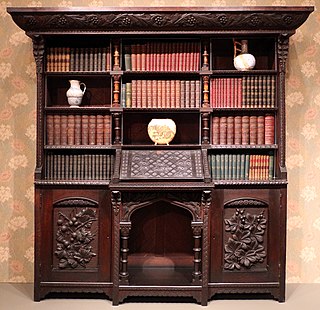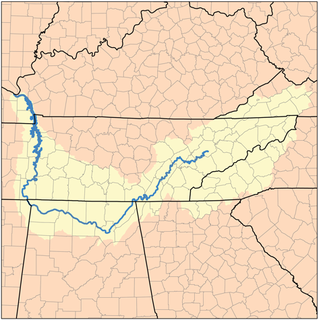Description
The counties that make up southwestern Virginia and northeastern Tennessee are linked historically, culturally, and geographically. The shared decorative arts tradition of this region is known as the Great Road Style, so called because of the region’s historical importance as a stage route connecting the eastern seaboard with the western frontier. The material culture of this region is evidenced in distinctive forms of furniture, ceramics, textiles, and metalwork.

Virginia, officially the Commonwealth of Virginia, is a state in the Southeastern and Mid-Atlantic regions of the United States located between the Atlantic Coast and the Appalachian Mountains. Virginia is nicknamed the "Old Dominion" due to its status as the first English colonial possession established in mainland North America and "Mother of Presidents" because eight U.S. presidents were born there, more than any other state. The geography and climate of the Commonwealth are shaped by the Blue Ridge Mountains and the Chesapeake Bay, which provide habitat for much of its flora and fauna. The capital of the Commonwealth is Richmond; Virginia Beach is the most populous city, and Fairfax County is the most populous political subdivision. The Commonwealth's estimated population as of 2018 is over 8.5 million.

Tennessee is a state located in the southeastern region of the United States. Tennessee is the 36th largest and the 16th most populous of the 50 United States. Tennessee is bordered by Kentucky to the north, Virginia to the northeast, North Carolina to the east, Georgia, Alabama, and Mississippi to the south, Arkansas to the west, and Missouri to the northwest. The Appalachian Mountains dominate the eastern part of the state, and the Mississippi River forms the state's western border. Nashville is the state's capital and largest city, with a 2017 population of 667,560. Tennessee's second largest city is Memphis, which had a population of 652,236 in 2017.

Furniture refers to movable objects intended to support various human activities such as seating, eating (tables), and sleeping. Furniture is also used to hold objects at a convenient height for work, or to store things. Furniture can be a product of design and is considered a form of decorative art. In addition to furniture's functional role, it can serve a symbolic or religious purpose. It can be made from many materials, including metal, plastic, and wood. Furniture can be made using a variety of woodworking joints which often reflect the local culture.
The first substantive effort to conduct primary research of the Great Road Style's decorative artifacts is Great Road Style: The Decorative Arts Legacy of Southwest Virginia and Northeast Tennessee, by Betsy White. The book involved thousands of hours’ worth of fieldwork conducted across Tennessee and Virginia in an attempt to offer the most detailed accounting possible of handmade objects produced along the Great Road before 1940.

The Great Road Historic District is a historic district in Lincoln, Rhode Island, commemorating a portion of Rhode Island's oldest highway, dating back to 1683. Great Road served as the main connection between Providence, Hartford and Worcester during colonial times. The district includes a 0.6-mile (0.97 km) section of the road, which winds along the Moshassuck River between a junction with Breakneck Hill Road and another with Front Street. Notable historic properties along this stretch of road include the National Historic Landmark Eleazer Arnold House, a stone-ender built in 1687, which is now a museum operated by Historic New England, the 1812 Moffett Mill, the Israel Arnold House, and Hearthside, the 1810 home of Stephen Smith, who established the adjacent Butteryfly Mill in 1811.
The eventual product of that exhaustive research was an archive of photographs, slides, and data sheets on more than two thousand objects representing diverse sectors of the survey area. In organizing and providing a narrative for this treasure trove of material, White and her research team have defined and delineated for the first time what constitutes Great Road Style.

Abingdon is a town in Washington County, Virginia, United States, 133 miles (214 km) southwest of Roanoke. The population was 8,191 at the 2010 census. It is the county seat of Washington County. The town encompasses several historically significant sites and features a fine arts and crafts scene centered on the galleries and museums along Main Street.

Appalachia is a cultural region in the Eastern United States that stretches from the Southern Tier of New York to northern Alabama and Georgia. While the Appalachian Mountains stretch from Belle Isle in Canada to Cheaha Mountain in Alabama, the cultural region of Appalachia typically refers only to the central and southern portions of the range, from the Blue Ridge Mountains of Virginia, southwesterly to the Great Smoky Mountains. As of the 2010 United States Census, the region was home to approximately 25 million people.
The Tri-Cities is the region comprising the cities of Kingsport, Johnson City, and Bristol and the surrounding smaller towns and communities in Northeast Tennessee and Southwest Virginia. All three cities are located in Northeast Tennessee, while Bristol has a twin city of the same name in Virginia.

This article is about tangible folk art objects. For performance folk arts, see Folk arts.

The Western Reserve Historical Society (WRHS) was founded in 1867, making it the oldest cultural institution in Northeast Ohio. WRHS is located in Cleveland, Ohio, USA, and is focused on the history of the Western Reserve. WRHS celebrated its 150th anniversary in 2017.

The Tennessee Valley is the drainage basin of the Tennessee River and is largely within the U.S. state of Tennessee. It stretches from southwest Kentucky to north Georgia and from northeast Mississippi to the mountains of Virginia and North Carolina. The border of the valley is known as the Tennessee Valley Divide. The Tennessee Valley contributes greatly to the formation of Tennessee's legally recognized Grand Divisions.

Appalachian music is the music of the region of Appalachia in the Eastern United States. It is derived from various European and African influences, including English ballads, Irish and Scottish traditional music, hymns, and African-American blues. First recorded in the 1920s, Appalachian musicians were a key influence on the early development of Old-time music, country music, and bluegrass, and were an important part of the American folk music revival of the 1960s. Instruments typically used to perform Appalachian music include the banjo, American fiddle, fretted dulcimer, and guitar.

The Skirball Cultural Center is an educational institution in Los Angeles, California devoted to sustaining Jewish heritage and American democratic ideals. It has been open to the public since 1996. The Center, named after philanthropist-couple Jack H. Skirball and Audrey Skirball-Kenis, features a museum with regularly changing exhibitions, film events, music and theater performances, comedy, family, literary and cultural programs. The campus includes a museum, a performing arts center, conference halls, classrooms, libraries, courtyards, gardens, and a café.

Southwest Virginia, often abbreviated as SWVA, is a mountainous region of Virginia in the westernmost part of the commonwealth. Located within the broader region of western Virginia, Southwest Virginia has been defined alternatively as all Virginia counties on the Appalachian Plateau, all Virginia counties west of the Eastern Continental Divide, or at its greatest expanse, as far east as Blacksburg and Roanoke. Another geographic categorization of the region places it as those counties within the Tennessee River watershed. Regardless of how borders are drawn, Southwest Virginia differs from the rest of the commonwealth in that its culture is more closely associated with Appalachia than the other regions of Virginia. Historically, the region has been and remains rural, but in the 20th century, coal mining became an important part of its economy. With the decline in the number of coal jobs and the decline of tobacco as a cash crop, Southwest Virginia is increasingly turning to tourism as a source of economic development. Collectively, Southwest Virginia's craft, music, agritourism and outdoor recreation are referred to as the region's "creative economy."
The Center for Folklife & Cultural Heritage (CFCH) is one of three cultural centers within the Smithsonian Institution. Its motto is "culture of, by, and for the people", and it is a steward and ambassador to cultures around the world. It does this by encouraging understanding and cultural sustainability through research, education, and community engagement. The CFCH differs in important aspects from the more conventional museums within the Smithsonian complex. It contains (numerically) the largest collection in the Smithsonian, but is not fully open to the public. Its budget comes primarily from grants, trust monies, federal appropriations, and gifts, with only a small percentage coming out the main Smithsonian budget.

Southern Highland Craft Guild is a guild craft organization that has partnered with the National Park Service for over fifty years. The Guild represents over 1000 craftspeople in 293 counties of 9 southeastern states. It operates four retail craft shops and two annual craft expositions which represents the Guild members' work. These expositions occur in July and October and has been an event in the Appalachian mountain region since 1948.
William King Museum of Art, located in Abingdon, Virginia, serves the Tri-Cities/Abingdon/Bristol, Tennessee and Virginia areas. Located in an historic 1913 building that is a fully renovated former school, the William King Museum of Art features galleries showcasing art of the region and of the world, both contemporary and historic. The museum also features resident artist studios, an outdoor sculpture garden and the VanGogh Educational Outreach Program.

The New Jersey State Museum is located at 205 West State Street in Trenton, New Jersey, overlooking the Delaware River. The museum is operated as part of the New Jersey Department of State. The museum's main collection of specimens, artifacts and objects date back to items collected in the early 19th century. The museum also includes a 140-seat planetarium and a 384-seat auditorium.

The Chester Inn State Historic Site is a former inn on the Great Stage Road at 116 West Main Street in Jonesborough, Tennessee. It was opened in 1797 by Dr. William P. Chester. It was the best hotel in the Tennessee frontier area.
C. Malcolm Watkins (1911–2001) was an American historian, archaeologist, and curator. He researched early American material culture, with a specific interest in the decorative arts. Watkins served as a head curator of the Department of Cultural History at the National Museum of American History at the Smithsonian Institution in Washington, D.C.. He spent a total of 31 years working at the Smithsonian.
The National Historic and Artistic Heritage Institute is a heritage register of the federal government of Brazil. It is responsible for the preservation of buildings, monuments, structures, objects and sites deemed of historic or cultural importance to the country. It currently holds 1,047 sites.

The Architecture of Kosovo dates back to the Neolithic Period and includes the Copper, Bronze and Iron Ages, Antiquity and the Medieval period. It has been influenced by the presence of different civilizations and religions as evidenced by the structures which have survived to this day. Local builders have combined building techniques of conquering empires with the materials at hand and the existing conditions to develop their own varieties of dwellings.

The Ancestral Puebloans were an ancient Native American culture that spanned the present-day Four Corners region of the United States, comprising southeastern Utah, northeastern Arizona, northwestern New Mexico, and southwestern Colorado. The Ancestral Puebloans are believed to have developed, at least in part, from the Oshara Tradition, who developed from the Picosa culture.
William M. Plummer (1873–1943) was an African American cabinetmaker and inventor from Smyth County, Virginia. His decorative work is part of both the tradition of American decorative arts and of African American folk art.
The Department of Arkansas Heritage (DAH) is a department of the U.S. State of Arkansas responsible for preserving, promoting and protecting Arkansas's natural and cultural history and heritage. The department consists of eight separate divisions: four heritage museums and four heritage resource agencies. The department’s central office coordinates and promotes all division efforts to make information and materials about the state readily accessible to all Arkansans through heritage and cultural events, educational resources and special publications. The common goal of all divisions is to seek out and protect the legacy and lore of Arkansas and what distinguishes it from other states.
















